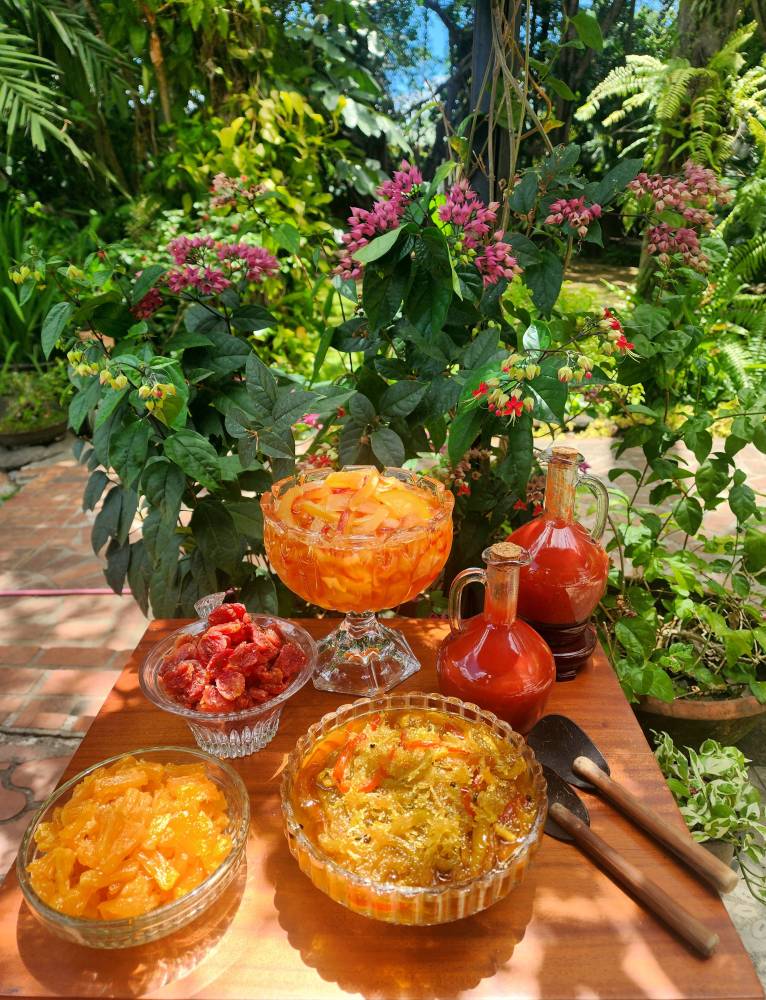Preserving the history of preserves in PH cuisine

It was a nostalgic Sunday morning in my kitchen as I recreated pickles, candied fruit and homemade ketchup.
Preserving fruits and vegetables was a significant part of my youth. Growing up, there was always minatamis and/or achara atop our table, which was why it became customary for us to enjoy eating sweet with savory.
Pickles and conserves were our pampagana.
I watched my mom make copious amounts of jam. I observed our manangs boil sugar syrup for saba and bayabas. On our lola’s kitchen counter were huge bowls of grated green papaya waiting to be transformed into achara. I vividly remember how mom made condol. Because of this, our family enjoyed various produce long past their seasons.
In celebration of National Food Month, I pay tribute to these age-old cooking methods, particularly pickling and conserving in syrup, to extend the edibility of food.
Tidbits of history
In data shared by renowned food historian Felice Prudente Sta. Maria, having preserves during bad weather, poor harvests and emergencies was important.
When the 19th turned into the 20th century, slices of hearts of coconut palm, grated unripe papaya, sliced or grated ginger, whole shallots and sliced radish were commonly made into pickles.
Further, Sta. Maria wrote that the Spanish word encurtidos (pickled appetizers), the Sanskrit-rooted achara and its nativized atsara coexist in the Filipino culinary vocabulary.
Fruits preserved in sugar are referred to by Spanish terms as en almibar (“in syrup”) and dulce, and the latter’s generic Filipino synonym, matamis.
Sta. Maria penned that in 1521, Magellan’s men found coconut vinegar being made in Cebu. There was, however, no mention made of pickling, and though coconut palm sugar cakes and honey were available when Magellan arrived in 1521, there were no records of conserving in syrup or honey.
In 1571, Miguel Lopez de Legazpi took possession of Manila. In 1572, he reported that three Chinese junks brought in sugar and candied sugar. The traders continued to bring sugar and raisins.
Sta. Maria added that 1590 records show that male and female slaves from India, Malacca and Maluco were brought to Manila; the women among them were excellent seamstresses, cooks and preparers of conserves.
Documents show inexpensive Chinese candies and confits served by Jesuits in 1596 to end their meals.
American colonials prided themselves in using science to manage the Philippine islands.
Home Economics (HE) was introduced locally in 1904, but there was no concerted plan for all its teachers. Domestic science and HE introduced the modern recipe, using standardized measures.
In 1911, the first published HE book was written by Alice M. Fuller, an HE teacher in Tuguegarao, Cagayan. The book was called “Housekeeping and Household Arts: A Manual for Work with Girls in the Elementary Schools of the Philippines.” It became a teacher’s guide and was recommended for student use in school and as a “cookbook at home.”
Pineapple, tomatoes
Before Maria Orosa became a food scientist in the 1920s, HE teachers taught how to preserve fruits and vegetables as pickles or sweets. Orosa would make recipes for Philippine ingredients, some unknown to Americans but popular among Filipinos.
Here are some recipes from the first HE book by Fuller.Pineapple was introduced by the Spanish to the Philippines. The fruit is native to the New World and associated with Brazil and the West Indies.
Peel and slice a good-sized pineapple. Put the fruit into a kettle with two glassfuls of sugar and one-half glass of water. Boil until fruit is tender. Remove fruit and spread on a dish to cool. Boil the syrup until thick. To test it, drop a little bit in cold water; it should make a soft ball. Return the fruit and stir for five minutes in the syrup, then spread the pineapple on platters to cool and harden.
Tomatoes were brought from Mexico to the Philippines. The first variety was smaller than a cherry tomato. It did so well in the Philippines that it grew wild.
Sta. Maria noted there was a time when one had to make ketchup if one wanted it. Heinz was the first to package ketchup for commercial sale. It reached the Philippines and became popular, especially by the 1930s.
Peel and cut up some tomatoes and onions, allowing one onion to six large ripe tomatoes. Cook for one-half hour and strain. Measure and return the tomato sauce to the fire. For each four cups full of sauce, mix in one cupful of sugar, one cupful of vinegar, one teaspoonful of salt, one of pepper, one of cloves and one of cinnamon. Pour this into the boiling tomato sauce. Boil 15 minutes longer, then take it from the fire and set it aside to cool. When cold, strain and put it into small bottles, filling them to the very top. Cork tightly and cover the tops with paraffin.
April is Filipino Food Month. Itaguyod natin ang Kalutong Pilipino.
Follow @iamreggieaspiras on Instagram and Facebook; visit reggieaspiras.com.


















